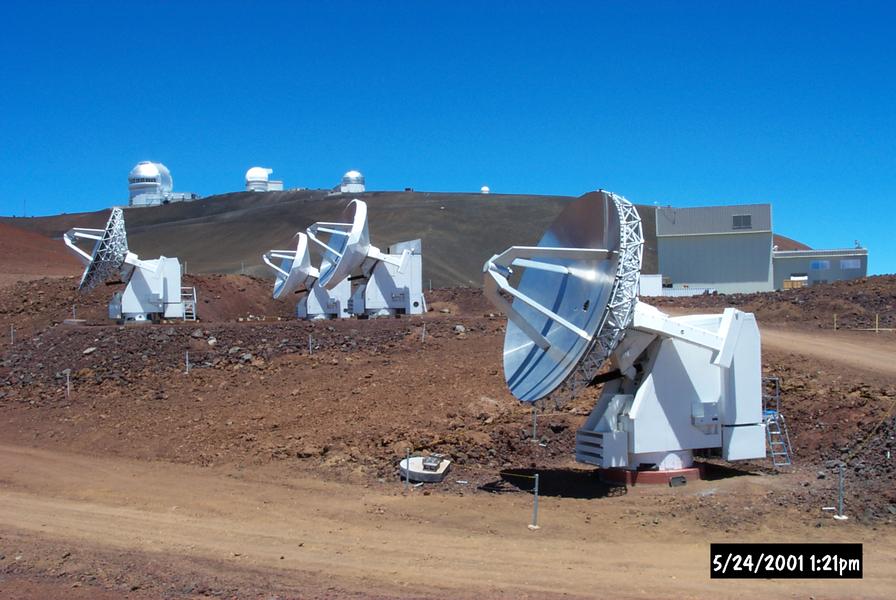
 Copyright © Michael Richmond.
This work is licensed under a Creative Commons License.
Copyright © Michael Richmond.
This work is licensed under a Creative Commons License.
Our Milky Way Galaxy contains more than 10 billion sun's worth of material floating between the stars in what astronomers call the InterStellar Medium, or ISM for short.
Astronomers studying the gaseous matter in interstellar space find that it comes in many different varieties. They call these structures "clouds". Unlike the clouds on Earth, however, many of the forms of interstellar clouds are completely invisible to the human eye. We need telescopes which span the entire electromagnetic spectrum in order to study these giant clouds of gas. Radio telescopes, like these in the Sub-Millimeter Array on Mauna Kea, are especially useful.

Why the radio? Well, much of the interstellar medium is cold. Really cold. The gas in some giant molecular clouds has a temperature of only 20 or 30 Kelvin.
Q: What is the peak wavelength in the
blackbody spectrum of radiation
emitted by these cold clouds?
Astronomers studying the ISM have found that about 90% of its atoms are hydrogen. The hydrogen in the ISM can be found in different states:
Component Temperature Density State
(K) (atoms/cm^3)
----------------------------------------------------------------------------
HI clouds 50 - 100 1 - 10^3 neutral atoms
Molecular clouds 20 - 50 10^3 - 10^5 molecules
WIM 10^3 - 10^4 0.01 partially ionized
HII regions 10^4 10^2 - 10^4 mostly ionized
Coronal gas 10^5 - 10^6 10^(-4) - 10^(-3) fully ionized
-----------------------------------------------------------------------------
Scientists use roman numerals to indicate the degree of ionization of elements: a one, "I", means "not ionized at all", a two, "II", means "one electron has been removed," a three, "III", means "two electrons have been removed," and so forth. Portions of the ISM composed mainly of neutral hydrogen are therefore called "HI clouds." These clouds are cold (T = 50 - 100 K), and mildly dense (1 to 1000 atoms/cm^3). While they are numerous and can found throughout the disk of the galaxy, individual clouds are relatively small, extending only over a few parsecs.
Detecting HI clouds directly was not possible until astronomers began using radio telescopes in the mid-1950s. Both the electron and the proton in an H atom have a property that is akin to the spin of a top. Electromagnetic interactions between the two particles can flip the spinning electron causing it to emit or absorb a photon with a wavelength 21 cm (which is in the radio part of the spectrum). These photons have such a long wavelength they can penetrate most intervening material. The prevalence of hydrogen gas along with the penetrating power of the 21-centimeter radiation it emits in neutral form have allowed astronomers to detect HI clouds across great distances and use them to map out the spiral structure of the Milky Way.
Compare these views of the Milky Way in visible light, and in the 21cm light of neutral hydrogen.


Molecular Clouds are the densest regions of interstellar space. Individual clouds may be more than one million times the mass of our sun. These structures play a crucial role in star formation.
Molecular clouds are formed primarily of hydrogen arranged in molecules consisting of two atoms: H2. Unfortunately for astronomers, hydrogen molecules are notoriously secretive. They don't interact with light in the visible part of the spectrum making them invisible to optical telescopes. In fact, under the conditions inside a molecular cloud. they don't emit or absorb much radiation at all, even in other regions of the electromagnetic spectrum.
To observe molecular clouds astronomer must rely on tracers, materials which make up only a small portion of a cloud, but which are easy to detect. We use tracers in ordinary life, too. For example, television executives want to know who's watching which television programs. They can't afford to ask directly the hundreds of millions of viewers, so they take an indirect approach: they pick a few thousand individuals and families and study their viewing habits. These households act as "tracers" for the entire population: if 30% of them watch a particular program, odds are that roughly 30% of everyone is watching it.
Astronomers use several kinds of tracers when studying molecular clouds. Dust makes a good tracer: particles embedded in molecular clouds can block light from background stars, revealing the cloud as a silhouette. When warmed by the radiation from nearby young stars, the dust can also glow in the far infrared and millimeter region of the spectrum.
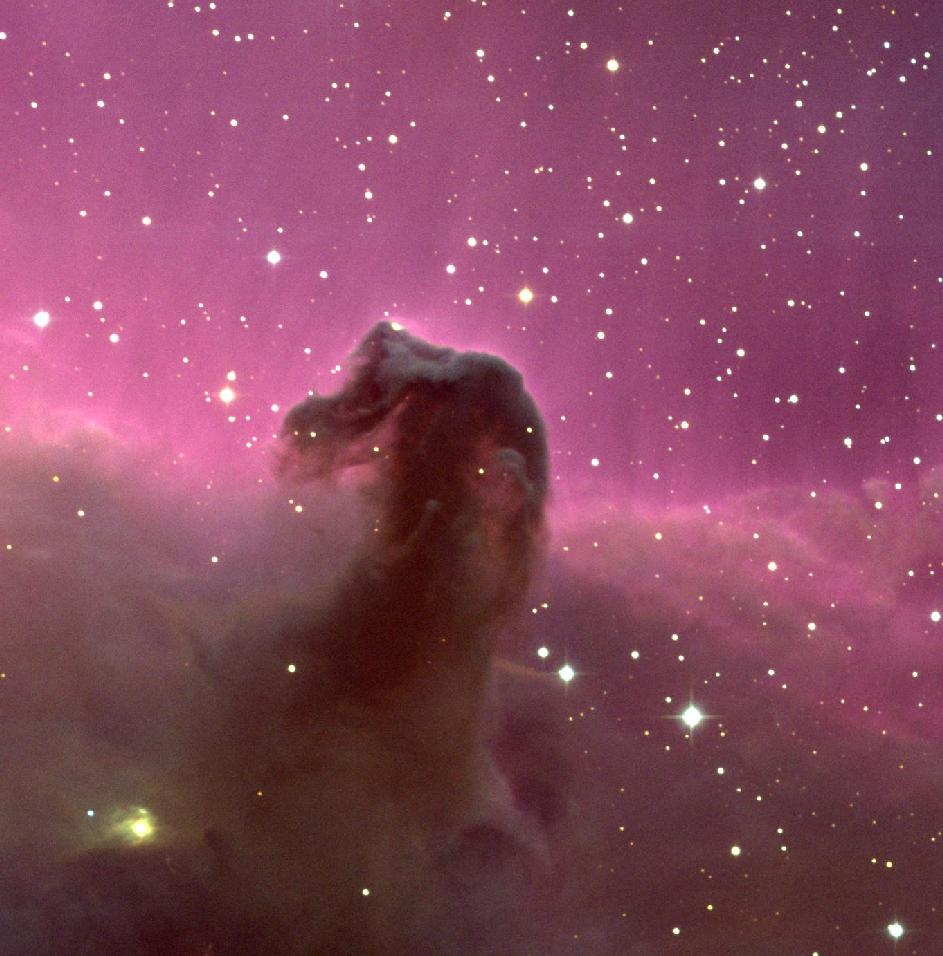
The best tracers for molecular clouds, however, turn out to be the molecules which live deep within them. Most molecules are quickly broken apart by ultraviolet radiation in space. Dense clouds, however, block ultraviolet photons very effectively. Deep inside the clouds, conditions are so favorable that a large variety of organic molecules have been detected.
Chemical Formula Molecule Chemical Formula Molecule ----------------------------------------------------------------------------- H2 molecular hydrogen | H2S hydrogen sulfide C2 diatomic carbon | N2O nitrous oxide CN cyanogen | H2CO formadehyde CO carbon monoxide | C2H2 acetylene NO nitric oxide | NH3 ammonia OH hydroxl | HCO2H formic acid NaCl sodium chloride | CH4 methane HCN hydrogen cyanide | CH3OH methyl alcohol H2O water | CH3CH2OH ethly alcohol -----------------------------------------------------------------------------
Carbon monoxide (CO) molecules, for example, can exist only deep inside dense clouds of hydrogen, protected by the outer layers of gas and dust. If we detect CO gas, we can conclude that there is also molecular hydrogen surrounding it. Because hydrogen atoms are so much more common than carbon and oxygen atoms, even a little CO implies a great deal of H2: a single CO molecule corresponds to over a million H2 molecules! Carbon monoxide is a handy tracer because, unlike molecular hydrogen, it emits and absorbs electromagnetic radiation efficiently. It is particularly active in the millimeter region of the spectrum. Astronomers are now building a number of arrays of telescopes sensitive to millimeter waves in order to study interstellar CO molecules in great detail -- which will tell us a great deal about the molecular clouds in which they live.
Compare this view of the Milky Way in visible light (again)
to the view as seen by a radio telescope looking at light emitted
by CO molecules.
The CO map shows the locations of dense clouds of molecular gas.


Q: Do neutral hydrogen clouds (HI)
and molecular hydrogen clouds (H2)
live in the same parts of our
Milky Way Galaxy?
Both the diffuse HI clouds and the molecular clouds are quite cold, with temperatures below 100 degrees Kelvin. There are, however, vast regions of the intergalactic medium that are quite hot. Between the denser, colder forms of interstellar gas lies the so-called Warm Intercloud Medium (WIM for short). Temperatures in the WIM are typically 10,000 degrees Kelvin. This gas is extremely tenuous: its typical density is only 0.01 atoms per cubic centimeter. The WIM extends across much of the galaxy and, despite its very low density, makes up almost 50% of the mass of the ISM.
The last form of the ISM that we will consider makes the "warm" gas of the WIM seem frigid in comparison. Between the other forms of interstellar matter are pockets of gas at temperatures of over one million degrees. This material is called "coronal gas", after a similarly hot region around the Sun called the solar corona. The coronal regions of the ISM are fantastically empty, with densities of 10^(-4) atoms per cubic centimeter. Astronomers believe that the hot coronal gas is material blown out of violent supernova explosions.
At such high temperatures, collisions between atoms in the coronal gas are able to rip electrons from their parent nuclei. Atoms in the coronal gas can be so highly ionized that we sometimes see light from ions like CIV (carbon missing three electrons) or OVI (oxygen missing five electrons).
Once again, compare the view of the Milky Way in visible (top) and in X-rays (bottom). The X-ray view shows the location of hot coronal gas. Note how the same dust clouds which block the visible light also block X-rays.


You've probably seen a number of beautiful color pictures showing clouds of gas in space glowing a deep red:
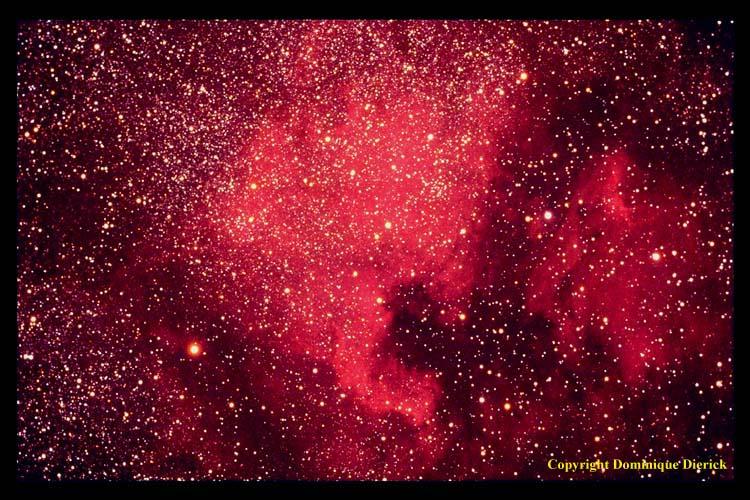
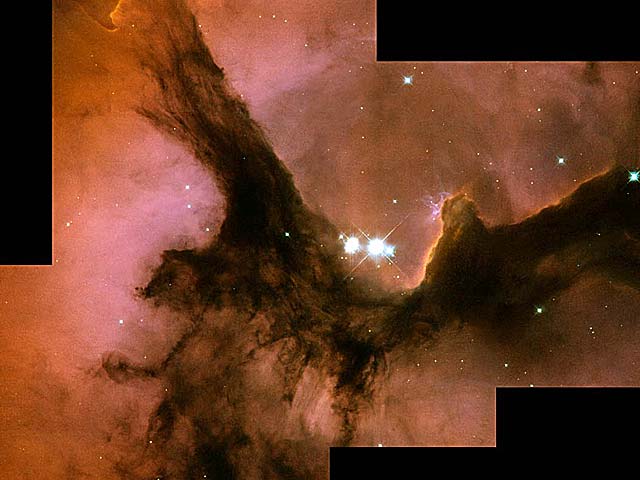
Taken from APOD.
Credit:
Hubble Heritage Team
(AURA /
STScI),
F. Yusef-Zadeh (Northwestern U.) et al.,
ESA,
NASA
or maybe even several different colors:
What's happening in these clouds is very similar to what's happening in the flourescent bulbs in the light fixtures above your heads right now:
Of course, the exact details are a big different:
light bulb H II region
----------------------------------------------------------------
electric current excited by a hot star
mercury vapor gas mostly hydrogen
under 1,000 temperature 10,000 degrees
----------------------------------------------------------------
These hot, glowing clouds of gas are called HII regions because most of the hydrogen in them is ionized (remember, a "I" suffix means "neutral gas", a "II" suffix means "ionized once", "III" means "ionized twice", and so on). They make up only a tiny fraction of the mass of the ISM throughout our galaxy, but they get most of the attention.
You can find a map showing the locations of HII regions across about half of the entire sky at the SHASSA WWW site. The SHASSA project used a very small telescope which ran robotically at an observatory in South America to scan large regions of the sky. It used a special filter to detect the Balmer alpha line of hydrogen from clouds excited by nearby hot stars.
Q: Compare the thickness of the Milky Way's disk
to the thickness of a CD. Which is thinner,
relative to its diameter?
The concentration of the ISM near the disk of our galaxy is an important clue to galactic ecology: the majority of stars are born and die in the same thin region of the disk. It appears that there is a strong link between the ISM and the formation and death of stars.
We can't see our entire Milky Way galaxy at once, because we're stuck inside it. But we can see other spiral galaxies. The Andromeda Galaxy (M31), one of our closest neighbors, probably looks a good deal like the Milky Way. Compare the views of Andromeda at different wavelengths by clicking on the picture below; each accentuates a different component of the galaxy.
If we could fly up above the plane of our Milky Way galaxy and look down on the disk, we might see a distribution of gas like this:
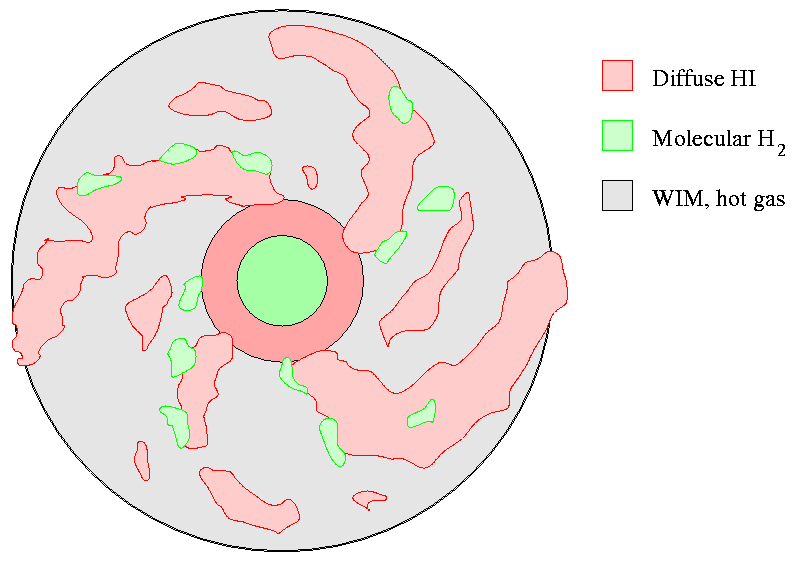
 Copyright © Michael Richmond.
This work is licensed under a Creative Commons License.
Copyright © Michael Richmond.
This work is licensed under a Creative Commons License.